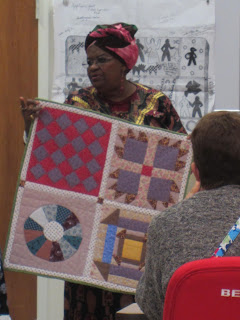I've always been impressed with this shop. It's practical, it's patriotic, the owners are Christians and make no bones about it, the store has a neat layout (though not fully accessible) and their class schedule always looks interesting.
They offered a Saturday lecture on the use of quilts in the Underground Railroad, given by Hattie Schmidt, who is recognized by the Smithsonian as a quilt historian. It was interesting and entertaining, but she talked more about African quilts and artwork and slavery than she did the topic matter. And for me that was a little disappointing.
Some of the quilt blocks she used during her 30 minute Underground Presentation (out of a 3hr lecture). One thing I learned: In the log cabin blocks (the first 2), the color of the center square indicated what time a slave was to leave on the journey north (indigo for night, yellow for daytime, orange for sunset). I don't know what the third one was, but the last one, called a bow tie, symbolized a place where slaves could go to get clothes, as if they were in their slave garbs they would easily be recognized.
And while I'm familiar with these blocks, she didn't tell what they represent. (Diamond, bear claw, wagon wheel an dI don't know the name of the last one)
She grew up in Wilmington, NC and this was a really cool quilt that she made. The stripes of fabric and the colors are all very common in quilts made by African-American women, but she used photographs from segregated Wilmington. In the right of this photo, the top building is the first colored hospital, and the brick building directly under it was its replacement, where she was born. One of her relatives is in the nurse's uniform beside it, and she worked there.
An African piece of fabric. This is not woven, but the dark color is actually made by placing mud on top of the fabric and leaving it to dry out in the sun for several days. The chemicals from the mud basically dye the fabric. Some of the group who know about printing fabrics were most intrigued by this piece of material.
And the above quilt is one of hers. The pattern is an Irish Chain, which is usually done two colors. I've always loved this pattern, and it was totally fascinating to see how making it with patchwork totally changed the look of the quilt. Making it even livelier was her applique in the centers of the white pieces. She used African symbols to go along with her African prints, and it truly looked like a new pattern. I found it very creative.
It was a good day, and I was thankful to have a friend ride along with me, even if the lecture strayed quite a bit from its topic!







No comments:
Post a Comment